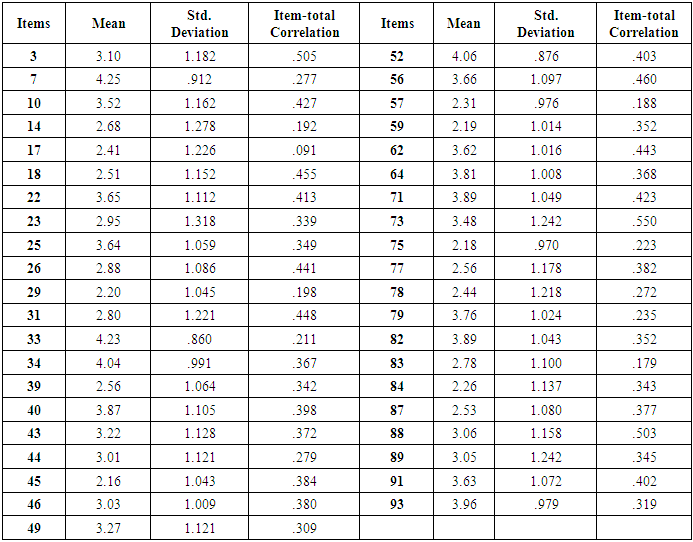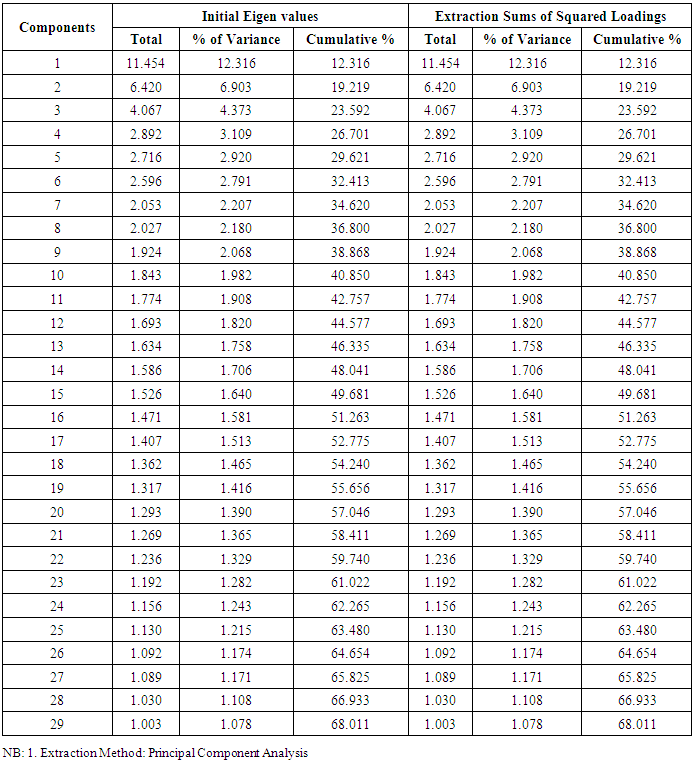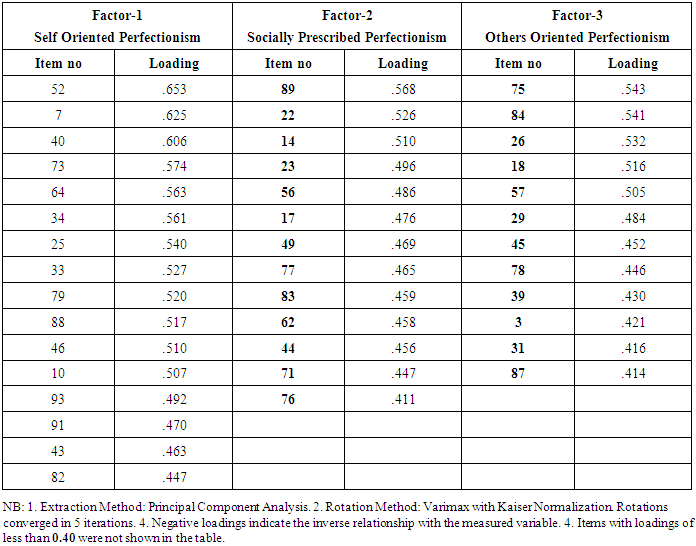-
Paper Information
- Paper Submission
-
Journal Information
- About This Journal
- Editorial Board
- Current Issue
- Archive
- Author Guidelines
- Contact Us
International Journal of Psychology and Behavioral Sciences
p-ISSN: 2163-1948 e-ISSN: 2163-1956
2016; 6(5): 206-212
doi:10.5923/j.ijpbs.20160605.02

Development and Validation of Perfectionism Scale for Indian Adults
1Institute of Aerospace Medicine, IAF, Bangalore, India
2Defence Institute of Psychological Research, DRDO, Delhi, India
Correspondence to: Kalpna Anand, Institute of Aerospace Medicine, IAF, Bangalore, India.
| Email: |  |
Copyright © 2016 Scientific & Academic Publishing. All Rights Reserved.
This work is licensed under the Creative Commons Attribution International License (CC BY).
http://creativecommons.org/licenses/by/4.0/

There are varieties of definitions of perfectionism owing to diverse conceptualizations as understood by different researchers based on culture. Perfectionism can be defined as striving for or the tendency to maintain or to reach unreasonably high standards. Perfection is an emerging construct in India. Confining to the various definitions of perfectionism, the present study endeavours to evolve a perfectionism scale for youth in the Indian context since India has a culture very different from the countries where existing scales were developed. Based on Hewitt & Fletts’s perfectionism model and expert reviews, various attributes of perfectionism scale were initiated with a pool of 129 items. These items were subjected to subject matter experts’ opinion and reduced to 93. The scale was administered on a sample of 531 participants and the item analysis was carried out and the items having a value of 0.40 and above were retained for factor analysis. After initial factor analyses the scale was again administered on a sample of 281 participants. The principal component analyses were employed and 41 items were retained covering three factors i.e. Self Oriented Perfectionism, Socially Prescribed Perfectionism and Others Oriented Perfectionism. The measure demonstrated high internal consistency; the reliability was 0.896 and validity was 0.486.
Keywords: Factor Analysis, Perfectionism, Youth
Cite this paper: Kalpna Anand, YK Nagle, Development and Validation of Perfectionism Scale for Indian Adults, International Journal of Psychology and Behavioral Sciences, Vol. 6 No. 5, 2016, pp. 206-212. doi: 10.5923/j.ijpbs.20160605.02.
1. Introduction
- Perfectionism is a multidimensional construct with both positive and negative dimensions, which can be either adaptive or maladaptive. Perfectionism has been described as the desire to achieve ambitious- and perhaps faultless standards [1]. Perfectionism can also be defined as striving for flawlessness [2] or the tendency to maintain or to reach unreasonably high standards [3].Three dimensions of perfectionism were identified, i.e. self-oriented perfectionism, other-oriented perfectionism and socially-prescribed perfectionism [4]. Individuals with high self-oriented perfectionism have unrealistic standards for themselves, they strive hard for these standards, are overly critical of themselves, tend to overly focus on their flaws, and try to avoid failure. In other-oriented perfectionism, individual has unrealistic standards and expectations about the abilities of others, and is often overly evaluative of others’ performance. In socially-prescribed perfectionism, individual believes that others have perfectionist expectations and motives about them, and they must attain these standards [5, 6, 4, 7-11]. Many researchers found that maladaptive forms of perfectionism were consistently linked with negative outcome variables such as higher levels of perceived stress [12] (Chang, Watkins, & Banks, 2004), psychological distress [13-15]. However, findings related to adaptive forms of perfectionism have not been as consistent. In a review, on the basis of large no. of literature of review it was found that there is a link between adaptive perfectionism and a variety of positive outcome variables, such as positive affect and life satisfaction [16, 12], conscientiousness [18-20], active coping [21], and higher academic achievement [22, 19]. Despite the consistency of these findings, less is known about the role of broader contextual features within which youth perfectionism is situated. Cultural-religious factors such as family expectations, social pressures and personal obligations might directly impact youth functioning (and therefore potentially reduce the impact attributed to perfectionism), or they might alter the relationship between perfectionism and youth functioning.Concept of PerfectionismPerfectionism has been delineated in many and various ways according to a number of scholars. However, it seems that there is no generally accepted definition of perfectionism that takes into account the nature of the discipline, diversity of culture, diversity of status, and diversity of social setup, among others. Historically, perfectionism has been conceptualized as a one-dimensional construct [23], and there has been a particular focus on the negative correlates of perfectionism. Perfectionism has been associated with psychopathology, with psycho-dynamic theory stressing that perfectionism was a sign of neurotic and disordered personality. Even though studies have distinguished between two forms of perfectionism (normal and neurotic), at the end of 1970’s, the dominant view of the 1980’s was that perfectionism was always neurotic, dysfunctional and indicative of psychopathology [24]. Empirical findings supported this view. This changed at the beginning of the 1990’s, when two research groups independently demonstrated that perfectionism is multidimensional in nature, and provided perfectionism research with two multidimensional scales to capture the construct in all its facets [26, 27]. It proposed that six facets in the experience of perfectionism be differentiated- personal standards, organization, concern over mistakes, doubts about actions, parental expectations and parental criticism- indicating that perfectionists have high standards, value order and organization and try to attach great importance to past and present evaluations by their parents. On the other hand, proposed that three facets of perfectionism be differentiated- self oriented perfectionism, socially prescribed perfectionism and other oriented perfectionism- indicating that perfectionists may see their high standards as self-imposed or as imposed by others and that they may equally have high expectations of others [26]. In recent years, one significant development in the perfectionism literature has been the demonstration that the perfectionism construct has identifiable interpersonal components [27]. Currently, no single definition of perfectionism has been agreed upon in the literature [2, 28]. Inconsistencies in the conceptualization has always been a cause of concern and resulted in different usage of the same terms.Rationale of the StudyIn Western societies, perfectionism is generally regarded as positive quality yet is linked to many psychological problems. Furthermore, perfectionism is generally regarded as personality orientation which is linked to both maladaptive traits and negative outcomes and less frequently to adaptive traits and positive outcomes. India is a collectivistic society wherein the expectations of and obligations towards significant others, viz. family, friends, etc., play a very important in decision making, career choices and way of life in general.In literature, societal factors have also been linked to the development of perfectionism [29], especially during adolescence and young adulthood wherein the struggle to separate oneself from parents and define individuality is still on and on almost at its peak. It was also emphasized on the fact that social factors such as interaction with peers and broader cultural values are important contributors to the development and maintenance of perfectionism [30]. In collectivistic cultures Socially Prescribed Perfectionism should be more prominent which emphasizes self in relation to others [2].The aim of the study was to develop a scale of Perfectionism based on dimensions identified by Hewitt & Flett, for Indian Youth. The goal was to develop a concise measure, with sound psychometric properties including internal reliability, Test- Retest Reliability and validity. Hence, this paper describes the procedure followed for the development of the Perfectionism Scale for Indian youth (18 yrs and above).
2. Method
- Participants: 531 students (males = 319; females = 212) from seven cities (from seven states of India) participated in the study. Their mean age was 21.17 years (SD = 1.63). 197 of them were attending professional courses like engineering, business administration, etc and 334 of them were regular courses. 77% of the participants followed Hinduism and 9% followed Islam and 8% followed Sikhism. 76% of the participants belonged to urban areas and 24% were from rural background. The convenient sampling method was used to collect data.Material: The development of scale ensued in three phases: first, a development phase wherein the items were selected; second, a refinement phase, and finally the psychometric evaluation phase. The study was conducted to develop a scale for the Adults on Perfectionism based on Indian sample. It was kept in consideration that students in collectivistic societies view societal pressure differently from the individualistic societies, therefore all the items were created accordingly to represent their thought process and experiences better. Item Generation: A panel of psychologists was provided with the apriori dimensions based on Hewitt & Flett’s model to develop the item pool. This led to the generation of 129 items. These items were primarily screened for their face validity and content validity by a panel of six subject matter experts. Peer review discussions were carried out to check for the repetition of items, their intended meaning, linguistic appropriateness, culture freeness etc. Following the thorough peer review discussion, 93 items out of 129 were retained in the preliminary form of the Perfectionism scale. The items were then arranged in a numerical sequence with positive and negative statements placed in alternate to one another to avoid halo and horn effects. Thus out of 93 items 41 items were retained, representing Self oriented perfectionism (16 items), Socially prescribed perfectionism, (13 items), Others oriented perfectionism (12 items).Some of the items of the finalized scale are given below:Self Oriented Perfectionism ItemsI must try to surpass my previous performance.I must achieve my goal no matter what it takes.Socially Prescribed Perfectionism ItemsMy family gets upset with smallest mistakes I make.I try extra hard to achieve excellence to please my parents.Others Oriented Perfectionism ItemsIf others around me are not trying hard to be perfect then they are not good enough.Those who are important to me need not be the best.Editing was done for vocabulary appropriateness, connotative meaning, reframing of sentences in first person form was done as a final modulation of the scale before it was administered to the participants. The scale was designed in likert form of scale ranging from strongly disagree (SD) to strongly agree (SA) with score of 1 to 5 for the positive statements where as 5 to 1 in case of negative statements.Procedure: Principals of various colleges were approached to obtain permission to interact with students during classes. The scale was administered on 531 participants in 23 sessions for the ease of admissibility. The purpose and the nature of the study was explained to the participants and due permission was obtained before the administration of the scale. The participants were not given any monetary compensation for participating in this study. The data was scored as per the criteria of positive and negative statements. Thereafter it was entered in the excel sheet and analyzed for the errors and missing values so as to tune it for the utility in a statistical software (SPSS-21).
3. Results and Discussion
- Test construction was carried out for development of the Perfectionism scale. The means were analyzed and all items with extreme responses were deleted. Items were also analyzed for their item total correlations and items with low coefficients were deleted. The retained items, Means, Standard Deviation, Correlated item total correlations are displayed in table 1.
|
|
|
|
4. Limitations of the Research
- This instrument is specific to Indian and collectivistic society context and the results cannot be generalized to individualistic societies. Most of the participants belong to urban areas and all of them were pursuing higher education which is considered a limitation and necessitates further validation with rural sample as well. The study necessitates further research work to establish norms for various age groups and strata of society. The Perfectionism scale instigates plenty of deliberations and criticisms for its refinement. The views, opinions and criticism on this work will be welcomed as goodwill interest to refine the Scale.
 Abstract
Abstract Reference
Reference Full-Text PDF
Full-Text PDF Full-text HTML
Full-text HTML


